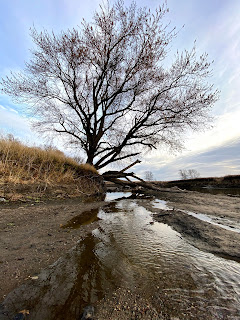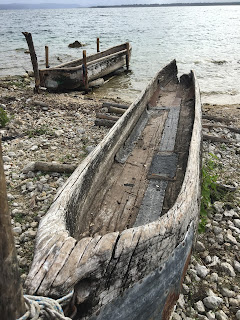When people ask me what I do I sometimes reply “I study the relationships between fish and forests.”
A more precise way to describe my job might be to say I’m a teacher, a scholar, and a department chair and program director at my university. But that answer is pretty dry and uninteresting.
Adding detail doesn’t always help, though I could say that I teach philosophy, classics, religious studies, theology, field ecology, study abroad, environmental studies, and sustainability; and that I take my students to the places I study: rainforests in the tropics and in Alaska, deserts, and the Mediterranean.
So instead I say “fish and forests.” The words are simple and easy to understand. I hope they invite more questions, and often they do.
 |
| Salmon bones on woody plants beside a river near Lake Clark, Alaska. A bear left these bones after a meal. |
The question I hope for is some version of “what do fish have to do with forests?” The short version is: nearly everything.
Nearly as good as that question is when someone points out that fish don’t live in trees. Short version of my reply: that’s not exactly true, and many of my students can tell you the various ways fish do live in trees. Here are a few:
Around the world, the edges between land and water are held together by roots, and in those places, fish find food, shelter, and places to spawn.
A great example of this is mangroves, which are some of the most important ocean nurseries. Thousands of species bear their young and lay their eggs in mangroves. The mangroves provide shelter from predators; they stabilize the soil, protecting land from hurricanes and strong waves, and protecting the sea from too much runoff. Birds, mammals, insects, and reptiles live in the branches. Fish and myriad aquatic invertebrates live among the roots.
 |
| A mangrove on an island off the coast of Belize. |
We could add that there are “forests” of kelp and coral underwater, too.
Wherever birds eat fish, those birds also build the soil when they return to the land. Their waste becomes fertilizer for all manner of grasses, forbs, and trees. Visit the rivers of Alaska and you will find shrubs and trees growing on the banks, where seeds found fertile gardens in mounds of bear poop.
When a bear eats salmon and berries, the berry seeds pass through the bear undigested. The bear deposits the seeds in a steaming pile of fecundity. Bears are forest gardeners.
Here in the middle, between the tropics and the Arctic, the
Big Sioux River is entering its quiet winter’s rest. We haven’t had much rain,
and the river is ankle-deep in many places. The fish gather in deep holes that were
sculpted out by fallen trees. When the river claims a tree, that tree doesn’t
simply float away. It becomes food for beavers and decomposing insects. It
creates eddies that dig deep holes on one side and deposit sediment on the
other. Sometimes the tree becomes a new island, and new trees grow up on its
rotting wood and on the debris it collects. Raccoons grab mussels and crayfish,
and eat them in the branches. Mink and otters dine from a similar menu further
down on the bank.
 |
| Tree growing on an island in the Big Sioux River. The tree makes habitat for both terrestrial and aquatic life. |
 |
| Near the roots, a deep hole has been carved out. Habitat for fish, hunting grounds for raccoons and other mammals. |
 |
| A fallen tree has created an island in the Big Sioux River |
Everywhere I go with my students I ask them to pay attention to the water. The fish and the forests alike need it. The forests keep the water cool and clean, and the fish fertilize the trees. Often, when I am teaching in Morocco or Spain or Greece, I ask them to notice the architecture of water, and the way it relates to our values. Religions have rituals of ablution, and ancient temples collect water from their rooftops, letting it flow down ancient marble columns that imitate the tree trunks that once made porticoes, to flow into cisterns. The narrative of the Christian scriptures begins in a forested garden, and ends in a city with a river flowing through it.
My students smile and roll their eyes at hearing me repeat the same question yet again. What do fish have to do with forests? What does water have to do with dry ground?
 |
| Traditional Itzá canoes on the shore of Lake Petén Itzá. |
And then one will point out a young mangrove shoot, a migrating salmon, a traditional Itzá canoe on a lakeshore, a baptismal font, a hammam, a public fountain, a Roman aqueduct.
And we will all stop for a moment and consider the way that this water, right here, flows through every part of our lives.
No comments:
Post a Comment